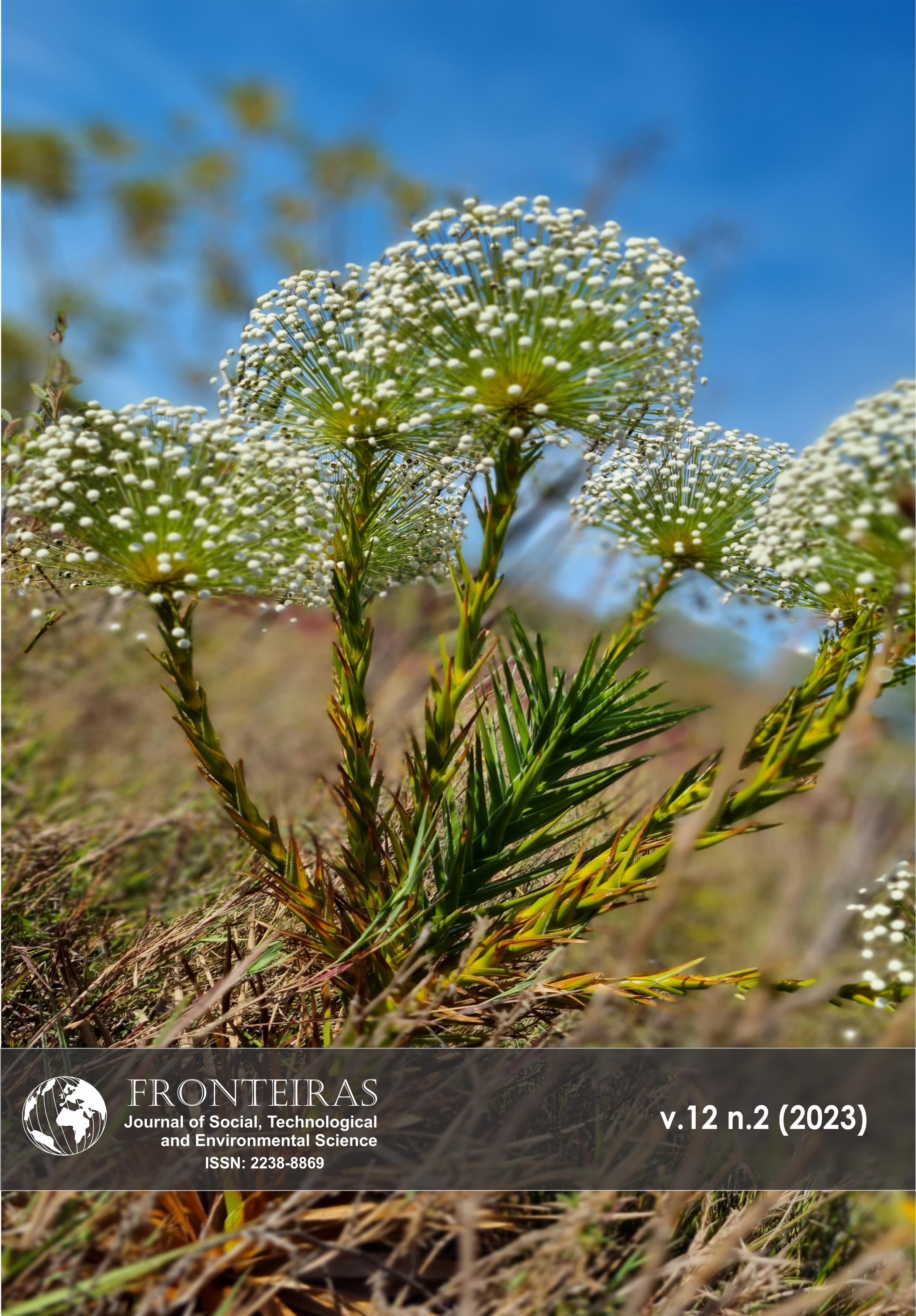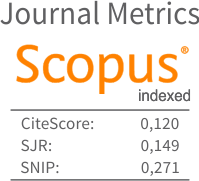Weed Control Strategies for Restoration of the Atlantic Forest in the State of Rio de Janeiro - Brazil
DOI:
https://doi.org/10.21664/2238-8869.2023v12i2.p129-143Palavras-chave:
environmental recovery, planting of seedlings, herbicidesResumo
The objective was to evaluate the best weed control strategy, for the formation of forest stands in Atlantic Forest, Brazil, aiming at restoration in an area dominated by Urochloa decumbes, evaluating the biological indicators and costs. It also sought to verify the magnitude of response of mechanical control compared to treatment without intervention, for similar sites where the experiment was installed and conducted. The treatments were: T1 - mechanical (mowing and crowning); T2 - chemical (application of glyphosate syrup); T3 - mechanical cultural (weeding, seeding and cultivation of Cajanus cajan and Canavalia ensiformes); T4 - chemical cultural (application of glyphosate, seeding and cultivation of legumes); T5 - absolute control (no intervention after planting). Activities and evaluations were carried out up to 30 months after planting the seedlings of the five species used. It was observed that in all treatments the survival of the plants reached values higher than 80%, at 6 and 18 months after planting. It was found that, on average, the tree plants in T2, T3, and T4 showed significantly higher growth than those in T1 and T5, which did not differ. The control with glyphosate is indicated for areas with predominance of Urochloa sp. Strategy control with glyphosate and cultivation of herbaceous legumes has potential use and needs adjustments to reduce costs. Also, that the control with mowing and crowning is not indicated due to the high cost and not favoring the growth of the planted trees, because it did not show significant differences in relation to the controls.
Referências
Brancalion, P.H.S., Isernhagen, I., Rodrigues, R.R., 2014. Adubação verde na restauração florestal, in: Ambrosano, E.J., Rosse, F., Carlos, J.A.D. (Eds.), Adubação Verde e Plantas de Cobertura No Brasil. Embrapa Informação Tecnológica, Brasília-DF, p. 478.
Campoe, O.C., Iannelli, C., Stape, J.L., Cook, R.L., Mendes, J.C.T., Vivian, R., 2014. Atlantic forest tree species responses to silvicultural practices in a degraded pasture restoration plantation: From leaf physiology to survival and initial growth. Forest Ecology and Management 313, 233–242. https://doi.org/10.1016/j.foreco.2013.11.016
CARVALHO, P.E.R., 2008. Espécies arbóreas brasileiras. Embrapa Florestas, Paraná.
CARVALHO, P.E.R., 2003. Espécies arbóreas brasileiras. Embrapa Florestas, Paraná.
Gonçalves, F., Aximoff, I., Resende, A.S. de, Chaer, G.M., 2021. Efficiency of Cardboard Crowning on the Suppression of Invasive Alien Grasses. Floresta Ambient. 28, 1–6. https://doi.org/10.1590/2179-8087-FLORAM-2021-0021
INEA, 2017. Resolução INEA n.o 143, de 16 de junho de 2017. Instituto Estadual do Ambiente. Diário Oficial do Estado do Rio de Janeiro, Rio de Janeiro.
Leles, P.S.S., Morais, L.F.D., Oliveira Neto, S.N., Alonso, J.M., 2015. Restauração florestal em diferentes espaçamentos, in: Leles, P.S.S., Oliveira Neto, F.M.O. (Eds.), Restauração Florestal e a Bacia Do Rio Guandu. Editora Rural, Seropédica-RJ, pp. 101–153.
Leles, P.S.S., Morais, L.F.D., Santos, F.A.M., Nascimento, D.F., 2017. Plantas companheiras para controle de plantas espontâneas na restauração florestal, in: Resende, A.S., Leles, P.S.S. (Eds.), Controle de Plantas Espontâneas Em Restauração Florestal. Embrapa, Brasília-DF, pp. 63–84.
Martins, E.M., Silva, E.R. da, Campello, E.F.C., Resende, A.S. de, Lima, S.S. de, Nobre, C.P., Correia, M.E.F., 2019. O uso de sistemas agroflorestais diversificados na restauração florestal na Mata Atlântica. Ciência Florestal 29, 632–648. https://doi.org/10.5902/1980509829050
Martins, S.V., 2020. Restauração florestal (Boletim de extensão). Universidade Federal de Viçosa, Viçosa-MG.
Melo, A.C.G. de, Miranda, D.L.C. de, Durigan, G., 2007. Cobertura de copas como indicador de desenvolvimento estrutural de reflorestamentos de restauração de matas ciliares no Médio Vale do Paranapanema, SP, Brasil. Rev. Árvore 31, 321–328. https://doi.org/10.1590/S0100-67622007000200015
Mueller-Dombois, D., Ellenberg, H., 1974. Aims and Methods of Vegetation Ecology. Blackburn Press, New Yersey.
Ribeiro, J.G., 2020. Dinâmica de plantas daninhas sob três técnicas de manejo na restauração florestal (Dissertação (Mestrado em Ciências ambientais e florestais)). Universidade Federal Rural do Rio de Janeiro, Seropédica-RJ.
Santana, J.E. da S., Leles, P.S. dos S., Resende, A.S. de, Dias, M.M.M., Carvalho, D.F. de, Lima, T.C. de, 2020a. INFLUENCE OF Urochloa brizantha ON THE GROWTH AND NUTRITIONAL ABSORPTION OF TREE SPECIES. FLORESTA 50, 1725–1730. https://doi.org/10.5380/rf.v50i4.60174
Santana, J.E. da S., Leles, P.S. dos S., Resende, A.S. de, Machado, A.F.L., Ribeiro, J.G., Gomes, R.F., 2020b. Grasses Control Strategies in Setting Restoration Stand of the Atlantic Forest. Floresta Ambient. 27, 1–10. https://doi.org/10.1590/2179-8087.006619
Santana, J.E.S., 2019. Estratégias de controle de convivência de Urochloa spp. em restauração florestal (Dissertação (Mestrado em Engenharia Florestal)). Universidade Federal Rural do Rio de Janeiro, Seropédica-RJ.
Santana, J.E.S., LELES, P.S.S., RESENDE, A.S., MACHADO, A.F.L., SILVA, A.C.R., LOPES, L.N., 2020. Interferência de Urochloa brizantha no crescimento e acúmulo de macronutrientes de plantas de Peltophorum dubium. Scientia Forestalis 48, e3079.
Santos, F.A.M. dos, Leles, P.S. dos S., Resende, A. da S., Nascimento, D.F. do, Santos, G.R. dos, 2020. Estratégias de controle de braquiárias Urochloa spp. na formação de povoamento para restauração florestal. Ciência Florestal 30, 29–42. https://doi.org/10.5902/1980509825559
Santos, F.A.M. dos, Leles, P.S. dos S., Santana, J.E. da S., Nascimento, D.F. do, Machado, A.F.L., 2018. Controle químico de plantas daninhas em povoamentos de restauração florestal. Pesquisa Florestal Brasileira 38, 1–9. https://doi.org/10.4336/2018.pfb.38e201701524
Santos, T.A., Resende, A.S., Silva, F.F., Moraes, L.F.D., Chaer, G.M., 2019. Growth of Tree Species in Coexistence with Palisade Grass Urochloa brizantha (Hochst. ex A. Rich.) Stapf CV. Marandu. Planta daninha 37, 1–10. https://doi.org/10.1590/S0100-83582019370100113
Scoriza, R.N., Silva, A. de P., Correia, M.E.F., Leles, P.S. dos S., Resende, A.S. de, 2015. Efeito de Herbicidas sobre a Biota de Invertebrados do Solo em Área de Restauração Florestal. Rev. Bras. Ciênc. Solo 39, 1576–1584. https://doi.org/10.1590/01000683rbcs20150096
Silva, A.A., Ferreira, F.A., Ferreira, L.R., Santos, J.B., 2009. Métodos de controle de plantas daninhas, in: Tópicos Em Manejo de Plantas Daninhas. UFV, Viçosa-MG, pp. 63–81.
Trentin, B.E., Estevan, D.A., Rossetto, E.F.S., Gorenstein, M.R., Brizola, G.P., Bechara, F.C., 2018. RESTAURAÇÃO FLORESTAL NA MATA ATLÂNTICA: PASSIVA, NUCLEAÇÃO E PLANTIO DE ALTA DIVERSIDADE. Ciênc. Florest. 28, 160–174. https://doi.org/10.5902/1980509831647
Turchetto, F., Araujo, M.M., Tabaldi, L.A., Griebeler, A.M., Rorato, D.G., Berghetti, A.L.P., Barbosa, F.M., Lima, M.S., Costella, C., Sasso, V.M., 2020. Práticas silviculturais intensivas impulsionam a restauração florestal no sul doBrasil. Ecologia e manejo florestal 473.
Downloads
Publicado
Como Citar
Edição
Seção
Licença
Esta revista oferece acesso livre imediato ao seu conteúdo, seguindo o princípio de que disponibilizar gratuitamente o conhecimento científico ao público proporciona maior democratização mundial do conhecimento.
A partir da publicação realizada na revista os autores possuem copyright e direitos de publicação de seus artigos sem restrições.
A Revista Fronteiras: Journal of Social, Technological and Environmental Science segue os preceitos legais da licença Creative Commons - Atribuição-NãoComercial 4.0 Internacional.


